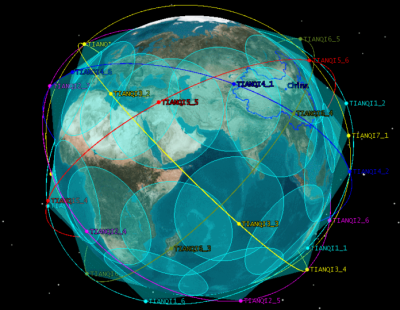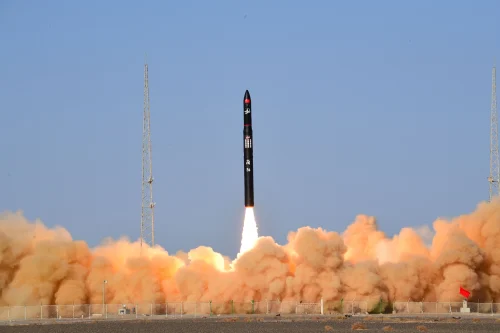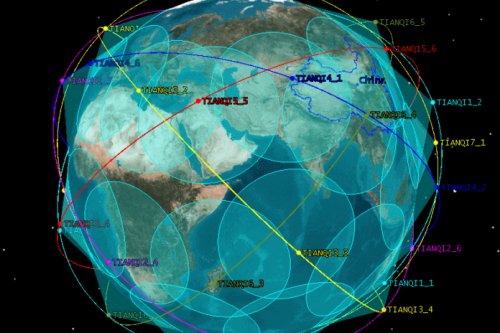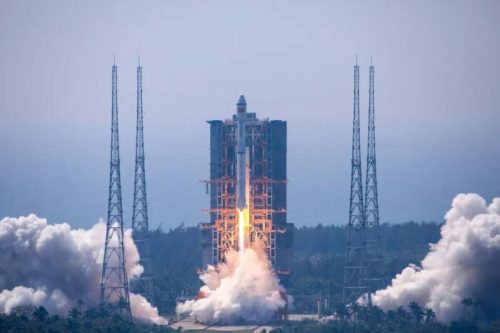Tianqi LEO satellite constellation

| Position: | LEO |
| Operator: | Guodian Gaoke |
| Launch operators: | CGWIC |
| Galactic Energy | |
| Launch vehicles: | Ceres 1 |
| Long March 2C | |
| Launch date: | |
| Expected lifetime: | 10 Years |
The Tianqi LEO satellite constellation is being built and operated by LEO satellite operator Guodian Gaoke (Guodian Gaokeji), a Chinese private commercial space company and leading provider of domestic satellite IoT. The company is building a Low Earth Orbit IoT narrowband constellation, Tianqi, composed of 38 LEO satellites, which aims at enhancing connectivity and efficiency through smart, connected devices.
Guodian Gaoke is based in Bejing and currently has 16 satellites in orbit and completed the first phase of the constellation deployment in July 2021. The satellites enable a fly-over every 1.5 hours and consequently an update of a given sensor’s status. This frequency is deemed sufficient for most applications of industry verticals targeted by the Chinese company.
In October 2018 Guodian Gaoke launched its first satellite, Tianqi-01, as a co-passenger to the Chinese-French Oceanography Satellite, CFOSAT, on a CZ-2C rocket operated by CGWIC from China.
On December 21st, 2020 the company launched Guodian Gaoke’s Tianqi-08 (Xingzuo-08) Nano-satellite, as part of a commercial Rideshare payload of five satellites, into orbit on CGWIC’s Long March 8 first mission, debuting an expendable booster intended to eventually be outfitted for recovery and reuse. The Long March 8 rocket took off from the Wenchang satellite launch center on Hainan Island, China’s newest spaceport.
On April 27th, 2021 launch provider CGWIC orbited nine Nano-satellites for Guardian Gaoke with a Long March 6 rocket on a rideshare mission.
On February 26th, 2022 a Long March 8 launcher, operated by CGWIC, orbited the Tianqi-19 Nano-satellite. The spacecraft was manufactured by Shandong Institute of Aerospace Electronics Technology for Guodian Gaoke and its Tianqi low-Earth orbit narrow-band Internet of Things constellation.
On December 9th, 2022 the company launched its Tanqi-7 Nano-satellite using the Jielong-3 rocket that made its maiden flight launching from a floating platform from the Yellow Sea. Jielong-03 or Smart Dragon-3 or SD-3, is operated by China Rocket, a spinoff of state-owned CALT.
| Satellite | Launch Date | Launcher | Launch Provider |
| Tanqi-01 | Oct 29th, 2018 | CZ-2C | CGWIC, China |
| Tanqi-02 | Aug 17th, 2019 | Jielong-1 | CASC, China |
| Tanqi-03 | June 5th, 2019 | CZ-11H | CGWIC, China |
| Tanqi-4A | Dec 7th, 2019 | Kuaizhou-1 | CASIC, China |
| Tanqi-4B | Dec 7th, 2019 | Kuaizhou-1 | CASIC, China |
| Tanqi-05 | Jan 15th, 2020 | CZ-2D | CGWIC, China |
| Tanqi-06 | Oct 26th, 2020 | CZ-2C | CGWIC, China |
| Tanqi-07 | Dec 9th, 2022 | Jielong-3 | China Rocket, China |
| Tanqi-08 | Dec 21st, 2020 | LM-8 | CGWIC, China |
| Tanqi-09 | Apr 27th, 2021 | CZ-6 | CGWIC, China |
| Tanqi-10 | July 25th, 2020 | CZ-4B | CGWIC, China |
| Tanqi-11 | Nov 7th, 2020 | Ceres 1 | Galactic Energy, China |
| Tanqi-12 | May 6th, 2021 | CZ-2C | CGWIC, China |
| Tanqi-14 | June 18th, 2021 | CZ-2C | CGWIC, China |
| Tanqi-15 | July 19th, 2021 | CZ-2C | CGWIC, China |
| Tanqi-19 | Feb 26th, 2022 | LM-8 | CGWIC, China |



